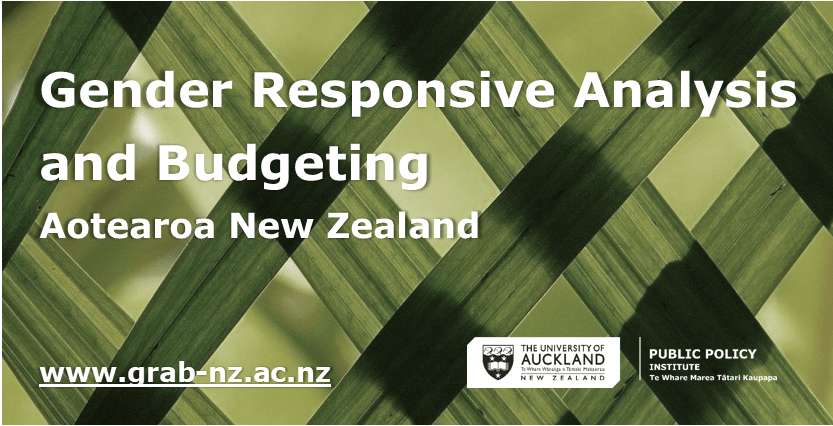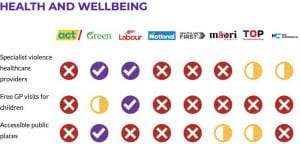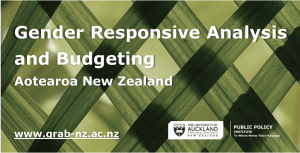Gender Analysis Briefing 1/2021
Sarah Bickerton, Jennifer Curtin, University of Auckland
Gender Justice Collective www.genderjustice.nz
Background
In 2020 a group of individuals and organisations, committed to a vision for Aotearoa as a place of leadership in gender equity, established the Gender Justice Collective (GJC). One of the GJC’s goals was to remind political parties of the need to address the diversity of women’s issues in their campaigns. Evidence was gathered via the GJC’s nationwide #YouChoose2020 survey to identify the election issues that were of most concern to women and non-binary persons in Aotearoa.
The election policies of eight political parties were analysed by the Gender Responsive Analysis & Budgeting team in the Public Policy Institute at the University of Auckland, off the back of the issues identified in the #YouChoose2020 survey. Together we produced the GJC Election Scorecard and the results were shared via a number of media outlets.
Given the policy holes identified during the analysis of the #YouChoose2020 survey data, the Gender Justice Collective pivoted to addressing one specific issue of concern – women’s health, and particularly the systemic underfunding of healthcare. While it had been highlighted by COVID-19, this had been a problem for a long time before the pandemic. After consulting a range of experts for input on the scope and range of issues of import, and after reviewing overseas models, the decision was made to campaign for the creation of a National Women’s Health Strategy, thereby connecting the various healthcare elements impacting women and non-binary persons in Aotearoa New Zealand.
Creating the Campaign – The Petition
In advance of International Women’s Day 2021, the GJC launched a petition to have NZ$6 million from
Budget 2021 committed to the development of a National Women’s Health and Wellbeing Strategy. The petition is supported by the Royal Australian and New Zealand College of Obstetricians and Gynaecologists (Shahtahmasebi 2021).
Celia Devenish, Chair of Te Kāhui Oranga ō Nuku (formerly the NZ Committee of the College), highlighted that they have long supported closing the gaps in women’s health services, and that such a strategy is necessary for a truly holistic and equitable approach to women’s wellbeing. Angela Meyer, a GJC founding member, says the campaign came from an urgent need to get women’s voices and stories heard at a political level, and to remind policy makers that there are a myriad of factors causing inequity of care.
What research tells us
The Gender Justice Collective’s #YouChoose2020 survey found that while 55% of respondents agreed that they can access everything they need to ensure health and wellbeing, a significant minority of women believed there remained significant gaps in health care services. Meyer (2021) lists a range of examples: the limited accredited training scheme for practitioners for inserting an IUD in Aotearoa New Zealand; that women aged 25- 33 are three times more likely than men to report unfulfilled prescriptions to due cost; the reluctance of successive governments to fund HPV self-testing (an initiative that could help to address the inequities Māori women face in regards to cervical cancers).
In her column for International Women’s Day, Alison Mau (2021) cites research which reveals medical staff don’t often talk about pelvic floor failure to pregnant people as a consequence of giving birth and, because they feel embarrassed, new parents don’t ask about it. Given one third of those that give birth experience prolapse, the absence of such conversations is concerning. Further, New Zealand’s maternity suicide rate is seven times higher than in the United Kingdom.
Professor Bev Lawton, Director of the Centre for Women’s Health Research Te Tātai Hauora O Hine, also reminds us of the inequities between women – Māori women are more likely than tauiwi to contract, and die from, breast, cervical and lung cancer. More recently, it has been women, particularly Māori & Pasifika women, who have borne the brunt of COVID-19 job losses, which is likely to bring with it additional health and wellbeing impacts (Witton 2021). And, despite a broad government commitment to evidence-informed policy making, there remains a dearth of research providing a systematic gender analysis of the health needs of intersex people and the extent to which health care quality for cis and trans women, wāhine, intersex, and non-binary people depends on where they live, how much money they have, and the colour of their skin (Meyer 2021).
Finally, it is clear that while New Zealand is progressing a wellbeing approach to policy making and the Budget, we are a laggard in terms of a national framework for women’s health. Equivalent strategies now exist in Australia, the United Kingdom, and Canada, because these governments recognise the need for a holistic strategic approach to and awareness of their women’s healthcare. Meanwhile researchers, doctors, and advocacy groups here argue that with the health policy changes recommended by the Health and Disability System Review and the continuing challenges posed by Covid19, now is time for a National Women’s Health Strategy for Aotearoa New Zealand.
Key points:
- The government needs to commit to creating a National Women’s Health and Wellbeing Strategy and Action Plan with a budget allocation of $6 million in 2021
- This is a necessary first step towards significantly improving the differential health outcomes between women and men and between different groups of women and girls
- The petition link is here and Budget Day is 20 May 2021





